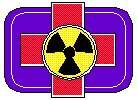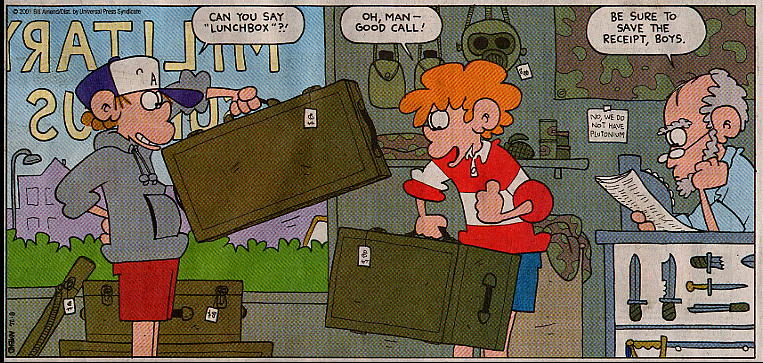Lost and Stolen Nuclear Materials in the United States
"...right now, people are being irradiated..."
Radiation can harm people without their knowledge since one can’t see it, hear it, feel it, taste it or smell it. You can be quite certain that there are numerous radioactive sources in a position to harm or ultimately kill someone. Some of these sources will have been intentionally placed to cause injury or even death. For example -- it is suspected that someone deliberately contaminated the water cooler at the National Institute of Health two years ago.
|
"Because of the lack of regulatory control, right now, people are being irradiated by some of the approximately 9000 missing nuclear sources without any means of detecting the danger that they’re in." Three Mile Island Alert Security Committee Chairman Scott Portzline |
Radioactive sources are being lost, stolen or illegally discarded every other day. Some of these are lost by overnight couriers. Nuclear contamination of packages, workers and delivery vehicles have occurred and you could one day receive a package which has been contaminated by a leaking source. Recently, a Federal Express jet was grounded until a radiation survey could determine if it was contaminated by a faulty shipment of radioactive material which had already irradiated other equipment, a vehicle and a person. A popular radioactive industrial gauge is stolen at the rate of once a month. When these are reported stolen, press releases are issued to warn the public of the danger.
Over the last 50 years, incidents of lost and stolen licensed radioactive devices occur at the rate of once every other day.
- 50 years x 52 weeks = 2600 weeks
- 9000 missing sources / 2600 weeks = 3.5 losses per week
- OR ------- 1 loss every other day
Incidents
· Two pieces of a fuel rod missing from Vermont Yankee
· Three sources of Cesium-137 are found beside an Orlando Florida road 2/21/2002
· A huge source-term of radioactive Iridium is reported lost during shipping by Purolator courier on 12/11/96
· A plot to deliberately contaminate/irradiate a man is discovered near Philadelphia and the source is recovered 1995
· The Millstone Nuclear Plant can't account for two highly radioactive fuel rods 4/16/2001 US Nuclear regulatory Commission Press Release
· A woman near Pittsburgh takes into her home a contaminated floor scrubber which has radioactive levels more than 1000 times considered safe 10/96
· A gauge containing Cesium-137 is found at a shopping mall in Arkansas 3/2/99
· The US Navy reports 38 new cooking pots are made from steel contaminated with Cobalt-60 6/3/98
· Recliner chairs parts are manufactured with Cobalt-60 contaminated steel in Indiana 6/10/98
· A $5000 reward is offered in Florida for finding a missing potentially deadly radioactive camera 3/17/99
· A researcher at the University of California intentionally places radioactive phosphorus on another researcher's chair to deliberately contaminate her 7/2/99 (discovered)
· A doctor in Indiana PA disregards radiation alarms after a procedure which leads to the irradiation of more than 90 persons and kills the patient 11/92
· A plutonium pacemaker is reported missing by a hospital near Philadelphia 12/11/96
· 11 adults and 2 children are exposed to high levels of radiation at a Houston scrapyard and five police officers are exposed to low levels while conducting interviews 3/5/96
· Cesium-137 is found in the trunk of a crushed car at a scrapyard in Cincinnati 5/31/96
· The FBI is called upon to investigate the circumstances surrounding the discovery of a large stash of radioactive materials in the Bronx New York. Investigators found Cesium, Radium, Strontium-90 and Carbon-14. 6/22/98
· Radioactive iodine is found in diapers at a garbage dump in Indianapolis 3/95
· For the third time in 2 months, a hospital in Minneapolis receives a radioactive contaminated package from the same corporation 12/19/96
· Five college-aged males are video taped stealing radioactive tritium from a glow-in-the-dark exit sign at Arizona State University on 10/26/96
· Deliberate contamination incidents at MIT and the National Institute of Health are investigated by the FBI Summer 1995
· Three New Jersey teenagers take a "glow-in-the-dark" exit sign containing 20 curies of tritium from a demolition site. They break open the tubes of tritium while eating sunflower seeds and thereby ingest some of the tritium. 5/10/97
· 33,000 shovel blades are made with steel contaminated with radioactive thorium near Harrisburg Pennsylvania 3/25/97
· Protective lead aprons for nuclear medicine workers are made from radioactive lead supplied from a company in Littlestown Pennsylvania 5/28/97
· 2,184 chemical agent detectors containing radioactive sources are reported lost in Europe by the US Army since 1989 4/22/97
· An Army surplus store in Fayetteville North Carolina sells a total of 42 personal lighting devices (map readers, personell illuminators, torches) containing a total of 90.35 curies of radioactive tritium to unknown individuals against NRC regulations
· A cleanup crew hired to dispose of chemicals at a high school discovers a radioactive source where none were reported in the inventory 7/18/96
· A package of radioactive thallium falls out of a Federal Express van and is stuck by a car releasing its contents, Michigan 3/29/95 A similar event occurs in Massachusetts 12/18/96
· A truck driver loses a contaminated valve he is hauling near Philadelphia Pa. The driver is contaminated. 3/27/97
· A Federal Express cargo van loses a package of radioactive Xenon when it falls out the unsecured back door in Sacramento California 7/1/97
· A nuclear plant workers puts a radioactive source into the coat pocket of a female worker near Chicago 1995
· A Russian-produced fuel assembly with 126 fuel rods containing 2% enriched uranium is unaccounted for by a US crew in Lynchburg, Va. 11/15/96
· Cesium-137 was found taped to the underside of the center drawer of a physician's desk at VA Medical Center Memphis, TN 05/22/93
· Someone put Strontium-90 in the rear pocket of a female worker at the Quad Cities Nuclear Plant 8/8/94
· A Brown University student was charged by police with attempting to poison his former girlfriend and her roommate by placing Iodine-125 in their food. 11/12/98
· Two men were arrested for plotting to kill three local officials by planting Radium-226 in their cars and food. Long Island, NY 6/11/96
The Nuclear Regulatory Commission is trying to find out why an ex-employee of an Armstrong County manufacturer of radioactive fuel for nuclear power plants took a dangerously contaminated floor scrubber home with her when she walked off the job three years ago.
The scrubber contaminated by more than 1,000 times the radiation levels that the NRC consider safe for public exposure was returned to the company’s plant a week ago by the former employee’s husband.
The company, Babcock and Wilcox of Apollo Pennsylvania, notified the NRC of the incident Thursday. Upon testing, the company found approximately 100 square centimeters of fixed alpha contamination and 100 square centimeters of fixed beta contamination.
Alpha contamination cannot penetrate skin, or even a thin piece of paper. But, beta is considered hazardous. Removable contamination can easily rub off, but the fixed does not.
The scrubber had 1.2 grams of radioactive residue on it - 1,000 times safe limits. "These are highly radioactive materials. Even very small amounts could pose a danger," said NRC spokesman Neil Sheehan. "Its not at all unusual that that type of material would be around." He said. "It is unusual that an employee like that would that type of material home."
Babcock and Wilcox officials could not be reached for comment. A security guard at the Apollo plant said everybody had left for the day and would not be back until Monday. A call to the company’s Lynchburg, Va. headquarters was not returned yesterday afternoon.
An NRC Region 1 inspector is on site in Armstrong County and is monitoring the company’s action, Sheehan said. He said Babcock and Wilcox has contacted the former employee to determine if and where the scrubber was used during the last three years and to make sure no radioactive materials remains in the public domain.
There was no information yet of any public contamination, Sheehan said.
"We still need to find out why this material was taken home and if any other materials were taken." He said.
It is too early to determine whether the employee will face criminal penalties or whether the NRC would seek criminal or civil penalties against the company, Sheehan said.
Bizarre Death of 82 Year Old Woman
The patient was taken back to her nursing home. For ten days, workers and visitors of the nursing home were unknowingly irradiated. The wire containing the seed fell out on the fourth day and disposed of in a medical biohazards bag which remained on site.
When the medical waste disposal truck arrived to haul the refuse, the driver failed to make a radiation survey with a portable survey meter as per company policy. The source was finally discovered at an incineration facility in Warren Ohio when radiation alarms indicated contamination.
Because the plant manager and supervisor could not determine which trailer contained the radioactive source, they decided to drive one tractor trailer at a time behind a concrete building to act as a shield. As soon as the trailer containing the radioactive source drove out from behind the building, the meter registered its highest level from 400 feet away. Upon searching the trailer, they were able to trace the bag to the nursing home.
An NCR incident Investigation team found that the patient received a serious mis-administration and had died five days after the failed treatment. The Indiana County Coroner’s report stated that the patient died of "Acute Radiational (sic) Exposure and the Consequences Thereof." Newspaper advertisements located some of the visitors to the nursing home who were irradiated. Some of the nursing home staff had what the NRC called "significant" doses. They determined that over 90 people were exposed.
Radioactive Train Gets Side-tracked
From NRC daily report 1/27/96
Radioactive Lighting for Sale
from NRC Daily Event Report on 2/18/97
Texas Theft Incident Irradiates Many
Scrap yards and refuse dumps should be required to have radiation monitors. The cost is only $800 per alarm but many facilities balk at the price. However, having the ability to monitor incoming scrap metal or refuse doesn’t guarantee that radioactive materials won’t get through the gates. A sealed source can go undetected and pose little threat to the public health and safety until it is opened accidentally or on purpose.
An undetected radioactive source in a load of scrap metal is often resold from one dealer to the next. The 1996 Houston Texas incident is a classic example of dishonesty and irresponsibility. It also demonstrate the lack of ability to detect, identify and take protective action.
from Nuclear Regulatory Commission briefing SECY-96-221
(background)
On February 27, 1996, two cobalt-60 cameras and an iridium-192 camera were stolen from a location in Houston, Texas. The company is in bankruptcy and the sources had been impounded in place by the Texas Department of Health, Bureau of Radiation Control (BRC). The Ir-192 had decayed to minimal activity. The Cobalt-60 cameras, one large (1665 lbs), and one small (631 lbs), contained 35.3 Curie and 8.6 Curie of Co-60 respectively.
The following chronology of events occurred after the devices were stolen.
In this case, BRC was notified by the Texas Natural Resources Conservation Commission, which was working at the site of the bankrupt company, that the door from the building where the devices were stored was removed. Upon investigation, BRC determined that the three devices had been removed. On March 4, 1996, BRC issued a news release that was highly publicized by the local media. This assisted in BRC eventually locating the devices.
Another incident in Illinois was discovered when a scrap dealer purchased a radiation detection instrument and found a radioactive source buried on the site. The source was discovered in backfill used to re-grade the site. Excavation of the area by an incident response team recovered the source. It was determined to be cesium-137 with an activity of approximately 370 mCi). Exposure rates were calculated to be 145 mrem/hr at 0.91 m (3 ft). There is no way of knowing how long the source had been on the site or whether it may have been exposing workers and other individuals prior to being discovered. The two i Potentially harmful nuclear tool stolen
Item was taken from company near Lancaster
By Garry Lenton
OF THE PATRIOT-NEWS August 25, 1998
In what seems like a case for Mulder and Scully of the "X-files,"police and nuclear regulatory officials are investigating the theft of a nuclear device stolen from a Lancaster County asphalt company Friday.
Missing is a Troxler Gauge, a 70 pound tool used to measure the density of asphalt.
It was taken from a locked storage shed at the McMinn’s Asphalt Co. in East Hempfield Twp., just north of Lancaster.
Though relatively harmless, the gauge could pose a health threat to the unwary if the stainless steel capsule containing Its 8-millicurie, cesium-137 power source were broken, said Neil Sheehan, a spokesman for the Nuclear Regulatory Commission.
"It's not a tremendous amount of radioactive materials, but this type of material should not be out. In the public domain without restrictions," he said. "That's why we're concerned that this gauge has disappeared."
Exposure to the unshielded cesium could be a health threat, Sheehan said.
The NRC regulates nuclear materials used in industry. Companies that use the devices must meet specific guidelines for storage. Employees who operate the gauges must be licensed.
The theft was discovered around 7 p.m. Friday by a McMinn employee, said Dennis Martin, a lab technician for the company.
The thieves removed the storage-shed door from its hinges to get to the device.
It was the only item missing from the shed, Martin said.
He said he is puzzled by the theft. The tool, which looks like a yellow box about 2 feet long and 6 inches square, with a handle attached, has a limited use.
"They're not going to take it to a flea market and sell it," he said.
Sheehan said Troxler gauges are frequently reported stolen and later returned. NRC officials are hoping that happens here.
"What's curious about this case is that there was another gauge in the storage facility, and they only took one," Sheehan said, "Which could lead you to believe that whoever took it didn't know what they were taking."
Scott Portzline, a member of the anti-nuclear group Three Mile Island Alert, said nuclear devices like the gauge disappear frequently.
"My research shows that nuclear material like this is lost, stolen or found every other day," he said.
Portzline, who tracks nuclear theft reports via the Internet, said he believes there is a black market for the gauges.
"It's a gut feeling, but I've seen some reports of three or four of them stolen from different businesses at the same time, as if some body is buying these all of a sudden.
The gauges cost about $7,500 to $10,000.
The Nuclear Regulatory Commission has only now (11/13/96) decided to address lost sources even though they have discussed it internally since 1984 and have known about the problem in the mid 1950's as the Atomic Energy Commission (AEC). The AEC created a general licensing system in 1959. General licensee are not subject to audits, inspections or even inventorying their radioactive sources with a state or federal agency such as the NRC. This system was intentionally designed to avoid the cost and man-hours by the Atomic Energy Commission for keeping track of all of these sources. There may now be up to 9000 orphaned licensed nuclear devices in the United States.
In 1984, the NRC did a sampling of general licensees to determine the care and control of the sources in their possession.
- 80% were unaware they were even in possession of a licensed device.
- 80% of the licensees were not aware of regulatory requirements.
- 30% could not account for at least one of their devices.
- 36 of the approximately 1000 devices could not be accounted for.
The Incentive to "Dump" is Too Great
No Volunteers
from the April 29, 1998 Federal Register
Survey of Steel Mills: Support of a Risk Assessment of Generally and Specifically Licensed Devices
AGENCY: Nuclear Regulatory Commission.
ACTION: Survey of Steel Mills: Withdrawal.
SUMMARY: On August 14, 1997, (62 FR 43556) NRC announced its intentions to conduct a survey of the steel industry for obtaining data tailored to a risk analysis. The survey would have provided empirical data about discoveries of radioactive material in the recycling stream. A risk analysis would use this information as the basis to systematically evaluate the effectiveness of current regulation and possible regulatory changes. The analysis supports regulatory changes toward improving the control of radioactive devices commonly used in many industries.
The NRC received three letters from trade associations and a steel mill. All of these letters indicated that their organizations would not support the survey. Because participation in the survey would be voluntary and the letters were negative, the response rate for the survey would likely be low, resulting in insufficient data for a risk analysis as originally planned. Therefore, the NRC has decided not to conduct the survey.
NRC is continuing the risk analysis with appropriate adjustments to accommodate for the lack of data available without the survey. The NRC will re-evaluate the need for the survey after the risk analysis is completed. If the NRC decides to conduct the survey at a later date, the survey will be announced in the Federal Register.
to monitor for radioactive materials.
- Log in to post comments







